Auditing and Assurance in Australia: ASA 315 and ASA 520 Analysis
VerifiedAdded on 2022/11/17
|5
|1647
|356
Report
AI Summary
This report analyzes auditing and assurance practices in Australia, focusing on the application of ASA 315 (Risk Assessment Procedures) and ASA 520 (Substantive Audit Procedures). Part 1 distinguishes between analytical procedures used for risk assessment and those used as substantive audit procedures, providing explanations and examples from a case study of Mirvac Group. Part 2 assesses audit risk, identifies key audit assertions, and outlines substantive tests for specific accounts, including Plant, Property, and Equipment (PPE), Investment Properties, and Revenue. The report highlights potential risks associated with each account, such as valuation and accuracy, and recommends specific audit procedures to mitigate these risks, referencing relevant auditing standards and literature.
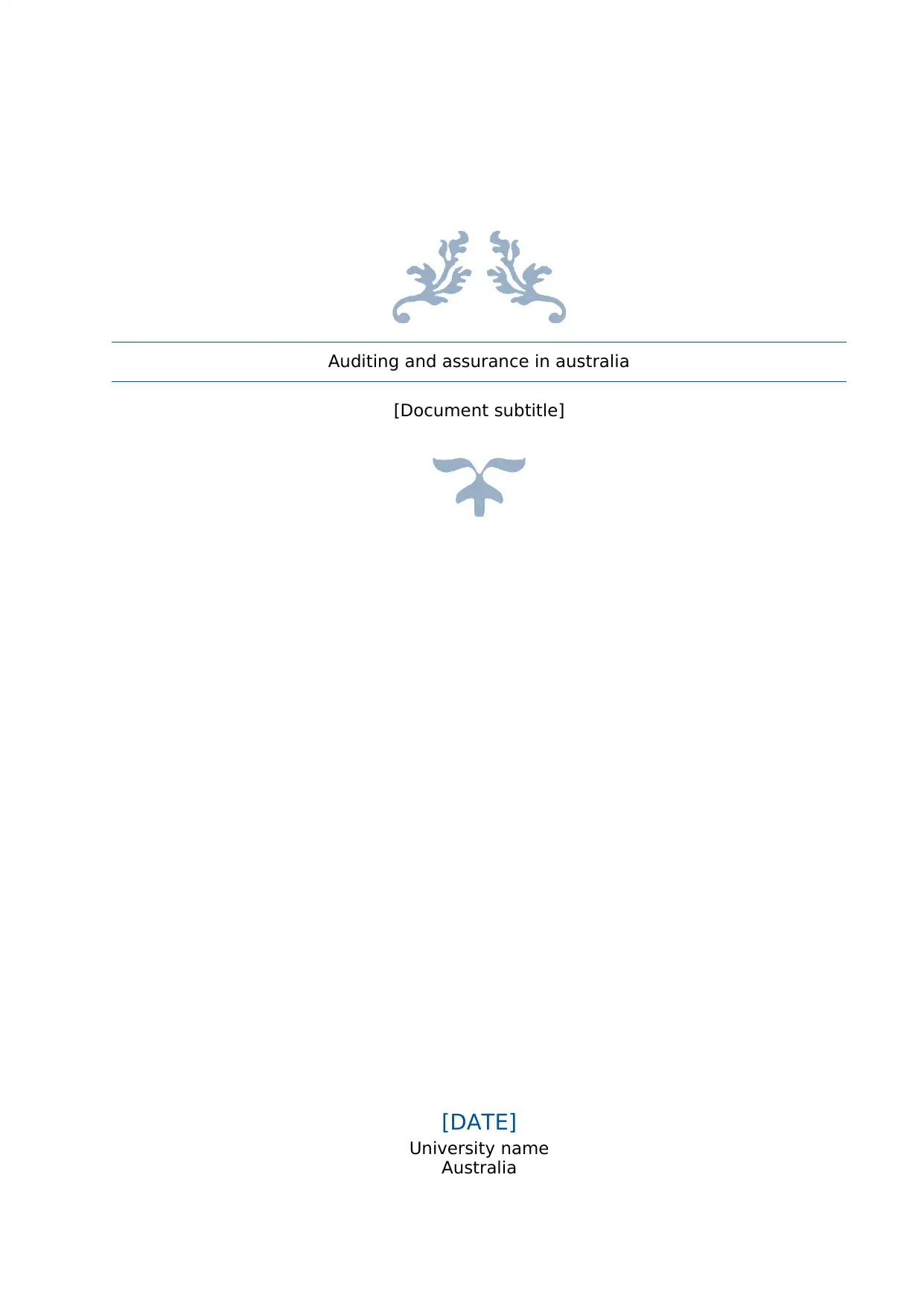
Auditing and assurance in australia
[Document subtitle]
[DATE]
University name
Australia
[Document subtitle]
[DATE]
University name
Australia
Paraphrase This Document
Need a fresh take? Get an instant paraphrase of this document with our AI Paraphraser
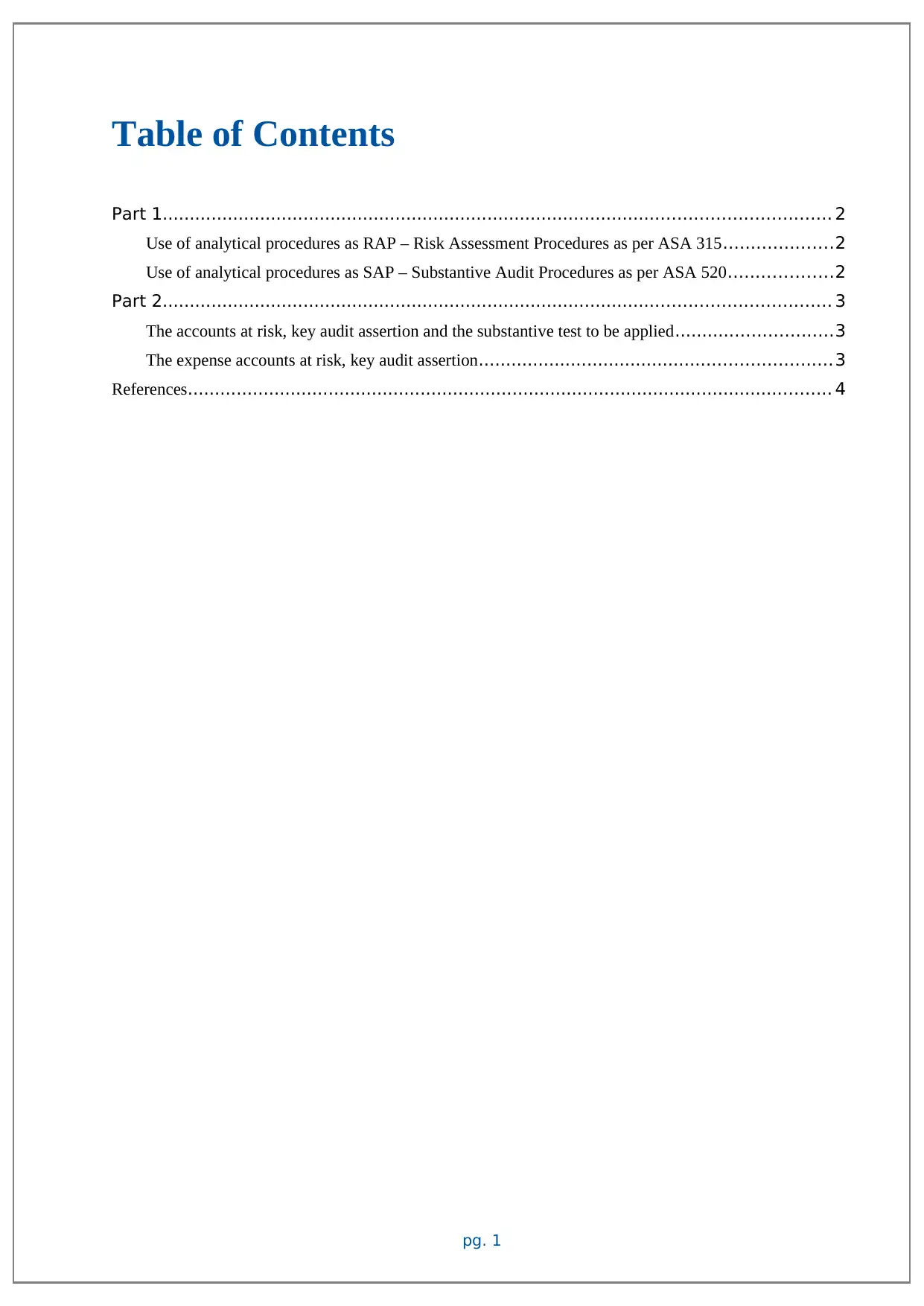
Table of Contents
Part 1........................................................................................................................... 2
Use of analytical procedures as RAP – Risk Assessment Procedures as per ASA 315....................2
Use of analytical procedures as SAP – Substantive Audit Procedures as per ASA 520...................2
Part 2........................................................................................................................... 3
The accounts at risk, key audit assertion and the substantive test to be applied.............................3
The expense accounts at risk, key audit assertion.................................................................3
References....................................................................................................................... 4
pg. 1
Part 1........................................................................................................................... 2
Use of analytical procedures as RAP – Risk Assessment Procedures as per ASA 315....................2
Use of analytical procedures as SAP – Substantive Audit Procedures as per ASA 520...................2
Part 2........................................................................................................................... 3
The accounts at risk, key audit assertion and the substantive test to be applied.............................3
The expense accounts at risk, key audit assertion.................................................................3
References....................................................................................................................... 4
pg. 1
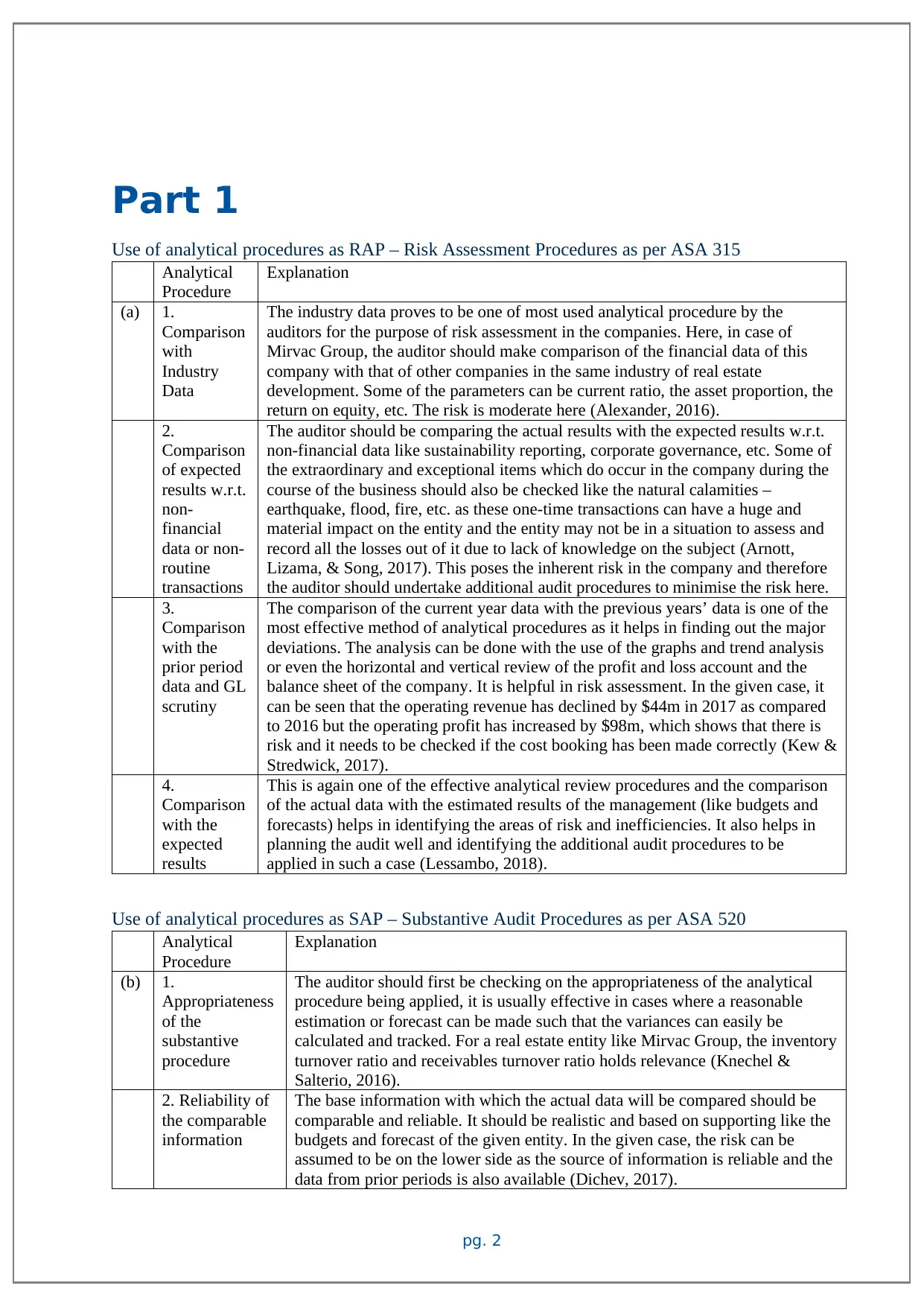
Part 1
Use of analytical procedures as RAP – Risk Assessment Procedures as per ASA 315
Analytical
Procedure
Explanation
(a) 1.
Comparison
with
Industry
Data
The industry data proves to be one of most used analytical procedure by the
auditors for the purpose of risk assessment in the companies. Here, in case of
Mirvac Group, the auditor should make comparison of the financial data of this
company with that of other companies in the same industry of real estate
development. Some of the parameters can be current ratio, the asset proportion, the
return on equity, etc. The risk is moderate here (Alexander, 2016).
2.
Comparison
of expected
results w.r.t.
non-
financial
data or non-
routine
transactions
The auditor should be comparing the actual results with the expected results w.r.t.
non-financial data like sustainability reporting, corporate governance, etc. Some of
the extraordinary and exceptional items which do occur in the company during the
course of the business should also be checked like the natural calamities –
earthquake, flood, fire, etc. as these one-time transactions can have a huge and
material impact on the entity and the entity may not be in a situation to assess and
record all the losses out of it due to lack of knowledge on the subject (Arnott,
Lizama, & Song, 2017). This poses the inherent risk in the company and therefore
the auditor should undertake additional audit procedures to minimise the risk here.
3.
Comparison
with the
prior period
data and GL
scrutiny
The comparison of the current year data with the previous years’ data is one of the
most effective method of analytical procedures as it helps in finding out the major
deviations. The analysis can be done with the use of the graphs and trend analysis
or even the horizontal and vertical review of the profit and loss account and the
balance sheet of the company. It is helpful in risk assessment. In the given case, it
can be seen that the operating revenue has declined by $44m in 2017 as compared
to 2016 but the operating profit has increased by $98m, which shows that there is
risk and it needs to be checked if the cost booking has been made correctly (Kew &
Stredwick, 2017).
4.
Comparison
with the
expected
results
This is again one of the effective analytical review procedures and the comparison
of the actual data with the estimated results of the management (like budgets and
forecasts) helps in identifying the areas of risk and inefficiencies. It also helps in
planning the audit well and identifying the additional audit procedures to be
applied in such a case (Lessambo, 2018).
Use of analytical procedures as SAP – Substantive Audit Procedures as per ASA 520
Analytical
Procedure
Explanation
(b) 1.
Appropriateness
of the
substantive
procedure
The auditor should first be checking on the appropriateness of the analytical
procedure being applied, it is usually effective in cases where a reasonable
estimation or forecast can be made such that the variances can easily be
calculated and tracked. For a real estate entity like Mirvac Group, the inventory
turnover ratio and receivables turnover ratio holds relevance (Knechel &
Salterio, 2016).
2. Reliability of
the comparable
information
The base information with which the actual data will be compared should be
comparable and reliable. It should be realistic and based on supporting like the
budgets and forecast of the given entity. In the given case, the risk can be
assumed to be on the lower side as the source of information is reliable and the
data from prior periods is also available (Dichev, 2017).
pg. 2
Use of analytical procedures as RAP – Risk Assessment Procedures as per ASA 315
Analytical
Procedure
Explanation
(a) 1.
Comparison
with
Industry
Data
The industry data proves to be one of most used analytical procedure by the
auditors for the purpose of risk assessment in the companies. Here, in case of
Mirvac Group, the auditor should make comparison of the financial data of this
company with that of other companies in the same industry of real estate
development. Some of the parameters can be current ratio, the asset proportion, the
return on equity, etc. The risk is moderate here (Alexander, 2016).
2.
Comparison
of expected
results w.r.t.
non-
financial
data or non-
routine
transactions
The auditor should be comparing the actual results with the expected results w.r.t.
non-financial data like sustainability reporting, corporate governance, etc. Some of
the extraordinary and exceptional items which do occur in the company during the
course of the business should also be checked like the natural calamities –
earthquake, flood, fire, etc. as these one-time transactions can have a huge and
material impact on the entity and the entity may not be in a situation to assess and
record all the losses out of it due to lack of knowledge on the subject (Arnott,
Lizama, & Song, 2017). This poses the inherent risk in the company and therefore
the auditor should undertake additional audit procedures to minimise the risk here.
3.
Comparison
with the
prior period
data and GL
scrutiny
The comparison of the current year data with the previous years’ data is one of the
most effective method of analytical procedures as it helps in finding out the major
deviations. The analysis can be done with the use of the graphs and trend analysis
or even the horizontal and vertical review of the profit and loss account and the
balance sheet of the company. It is helpful in risk assessment. In the given case, it
can be seen that the operating revenue has declined by $44m in 2017 as compared
to 2016 but the operating profit has increased by $98m, which shows that there is
risk and it needs to be checked if the cost booking has been made correctly (Kew &
Stredwick, 2017).
4.
Comparison
with the
expected
results
This is again one of the effective analytical review procedures and the comparison
of the actual data with the estimated results of the management (like budgets and
forecasts) helps in identifying the areas of risk and inefficiencies. It also helps in
planning the audit well and identifying the additional audit procedures to be
applied in such a case (Lessambo, 2018).
Use of analytical procedures as SAP – Substantive Audit Procedures as per ASA 520
Analytical
Procedure
Explanation
(b) 1.
Appropriateness
of the
substantive
procedure
The auditor should first be checking on the appropriateness of the analytical
procedure being applied, it is usually effective in cases where a reasonable
estimation or forecast can be made such that the variances can easily be
calculated and tracked. For a real estate entity like Mirvac Group, the inventory
turnover ratio and receivables turnover ratio holds relevance (Knechel &
Salterio, 2016).
2. Reliability of
the comparable
information
The base information with which the actual data will be compared should be
comparable and reliable. It should be realistic and based on supporting like the
budgets and forecast of the given entity. In the given case, the risk can be
assumed to be on the lower side as the source of information is reliable and the
data from prior periods is also available (Dichev, 2017).
pg. 2
⊘ This is a preview!⊘
Do you want full access?
Subscribe today to unlock all pages.

Trusted by 1+ million students worldwide
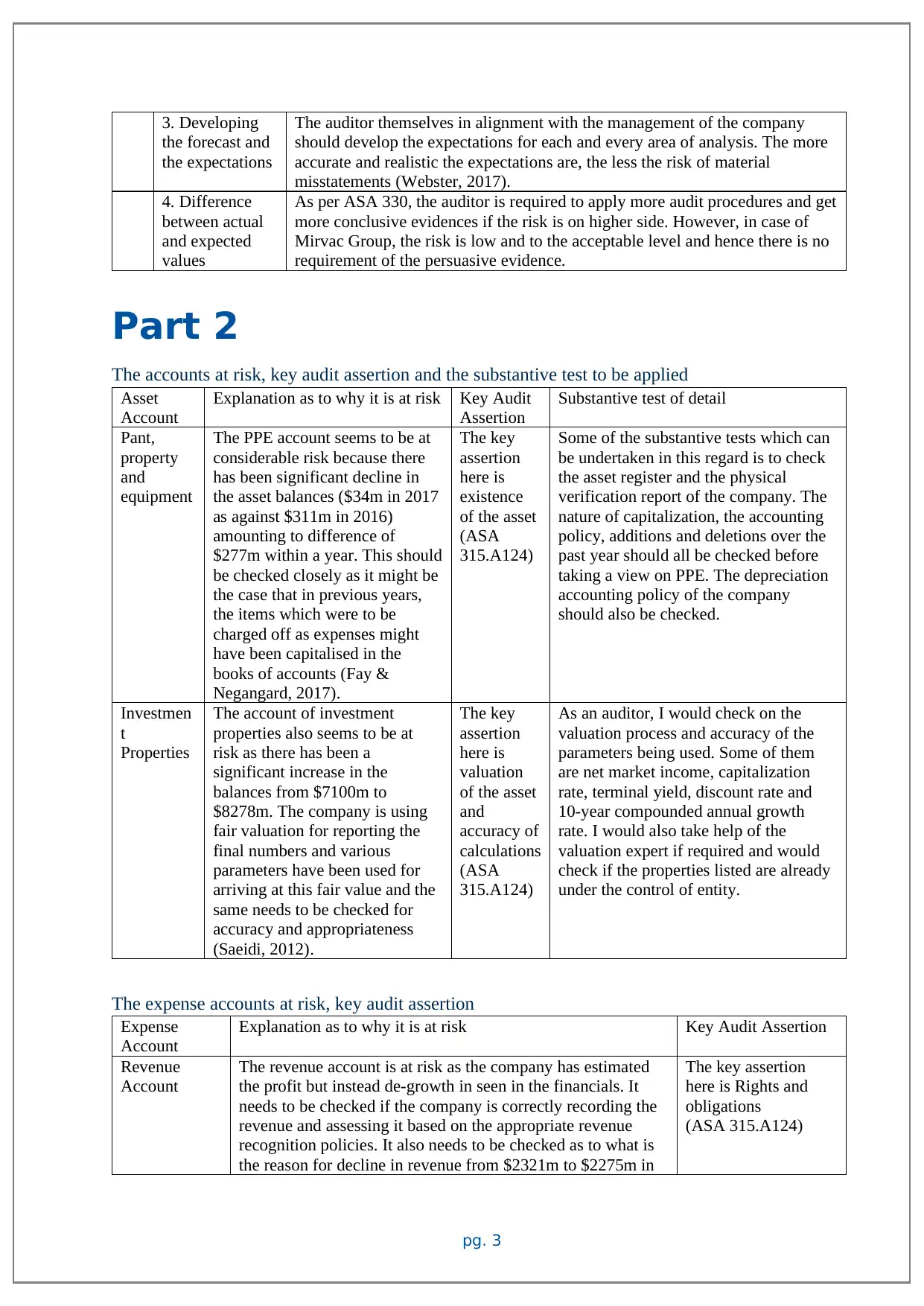
3. Developing
the forecast and
the expectations
The auditor themselves in alignment with the management of the company
should develop the expectations for each and every area of analysis. The more
accurate and realistic the expectations are, the less the risk of material
misstatements (Webster, 2017).
4. Difference
between actual
and expected
values
As per ASA 330, the auditor is required to apply more audit procedures and get
more conclusive evidences if the risk is on higher side. However, in case of
Mirvac Group, the risk is low and to the acceptable level and hence there is no
requirement of the persuasive evidence.
Part 2
The accounts at risk, key audit assertion and the substantive test to be applied
Asset
Account
Explanation as to why it is at risk Key Audit
Assertion
Substantive test of detail
Pant,
property
and
equipment
The PPE account seems to be at
considerable risk because there
has been significant decline in
the asset balances ($34m in 2017
as against $311m in 2016)
amounting to difference of
$277m within a year. This should
be checked closely as it might be
the case that in previous years,
the items which were to be
charged off as expenses might
have been capitalised in the
books of accounts (Fay &
Negangard, 2017).
The key
assertion
here is
existence
of the asset
(ASA
315.A124)
Some of the substantive tests which can
be undertaken in this regard is to check
the asset register and the physical
verification report of the company. The
nature of capitalization, the accounting
policy, additions and deletions over the
past year should all be checked before
taking a view on PPE. The depreciation
accounting policy of the company
should also be checked.
Investmen
t
Properties
The account of investment
properties also seems to be at
risk as there has been a
significant increase in the
balances from $7100m to
$8278m. The company is using
fair valuation for reporting the
final numbers and various
parameters have been used for
arriving at this fair value and the
same needs to be checked for
accuracy and appropriateness
(Saeidi, 2012).
The key
assertion
here is
valuation
of the asset
and
accuracy of
calculations
(ASA
315.A124)
As an auditor, I would check on the
valuation process and accuracy of the
parameters being used. Some of them
are net market income, capitalization
rate, terminal yield, discount rate and
10-year compounded annual growth
rate. I would also take help of the
valuation expert if required and would
check if the properties listed are already
under the control of entity.
The expense accounts at risk, key audit assertion
Expense
Account
Explanation as to why it is at risk Key Audit Assertion
Revenue
Account
The revenue account is at risk as the company has estimated
the profit but instead de-growth in seen in the financials. It
needs to be checked if the company is correctly recording the
revenue and assessing it based on the appropriate revenue
recognition policies. It also needs to be checked as to what is
the reason for decline in revenue from $2321m to $2275m in
The key assertion
here is Rights and
obligations
(ASA 315.A124)
pg. 3
the forecast and
the expectations
The auditor themselves in alignment with the management of the company
should develop the expectations for each and every area of analysis. The more
accurate and realistic the expectations are, the less the risk of material
misstatements (Webster, 2017).
4. Difference
between actual
and expected
values
As per ASA 330, the auditor is required to apply more audit procedures and get
more conclusive evidences if the risk is on higher side. However, in case of
Mirvac Group, the risk is low and to the acceptable level and hence there is no
requirement of the persuasive evidence.
Part 2
The accounts at risk, key audit assertion and the substantive test to be applied
Asset
Account
Explanation as to why it is at risk Key Audit
Assertion
Substantive test of detail
Pant,
property
and
equipment
The PPE account seems to be at
considerable risk because there
has been significant decline in
the asset balances ($34m in 2017
as against $311m in 2016)
amounting to difference of
$277m within a year. This should
be checked closely as it might be
the case that in previous years,
the items which were to be
charged off as expenses might
have been capitalised in the
books of accounts (Fay &
Negangard, 2017).
The key
assertion
here is
existence
of the asset
(ASA
315.A124)
Some of the substantive tests which can
be undertaken in this regard is to check
the asset register and the physical
verification report of the company. The
nature of capitalization, the accounting
policy, additions and deletions over the
past year should all be checked before
taking a view on PPE. The depreciation
accounting policy of the company
should also be checked.
Investmen
t
Properties
The account of investment
properties also seems to be at
risk as there has been a
significant increase in the
balances from $7100m to
$8278m. The company is using
fair valuation for reporting the
final numbers and various
parameters have been used for
arriving at this fair value and the
same needs to be checked for
accuracy and appropriateness
(Saeidi, 2012).
The key
assertion
here is
valuation
of the asset
and
accuracy of
calculations
(ASA
315.A124)
As an auditor, I would check on the
valuation process and accuracy of the
parameters being used. Some of them
are net market income, capitalization
rate, terminal yield, discount rate and
10-year compounded annual growth
rate. I would also take help of the
valuation expert if required and would
check if the properties listed are already
under the control of entity.
The expense accounts at risk, key audit assertion
Expense
Account
Explanation as to why it is at risk Key Audit Assertion
Revenue
Account
The revenue account is at risk as the company has estimated
the profit but instead de-growth in seen in the financials. It
needs to be checked if the company is correctly recording the
revenue and assessing it based on the appropriate revenue
recognition policies. It also needs to be checked as to what is
the reason for decline in revenue from $2321m to $2275m in
The key assertion
here is Rights and
obligations
(ASA 315.A124)
pg. 3
Paraphrase This Document
Need a fresh take? Get an instant paraphrase of this document with our AI Paraphraser
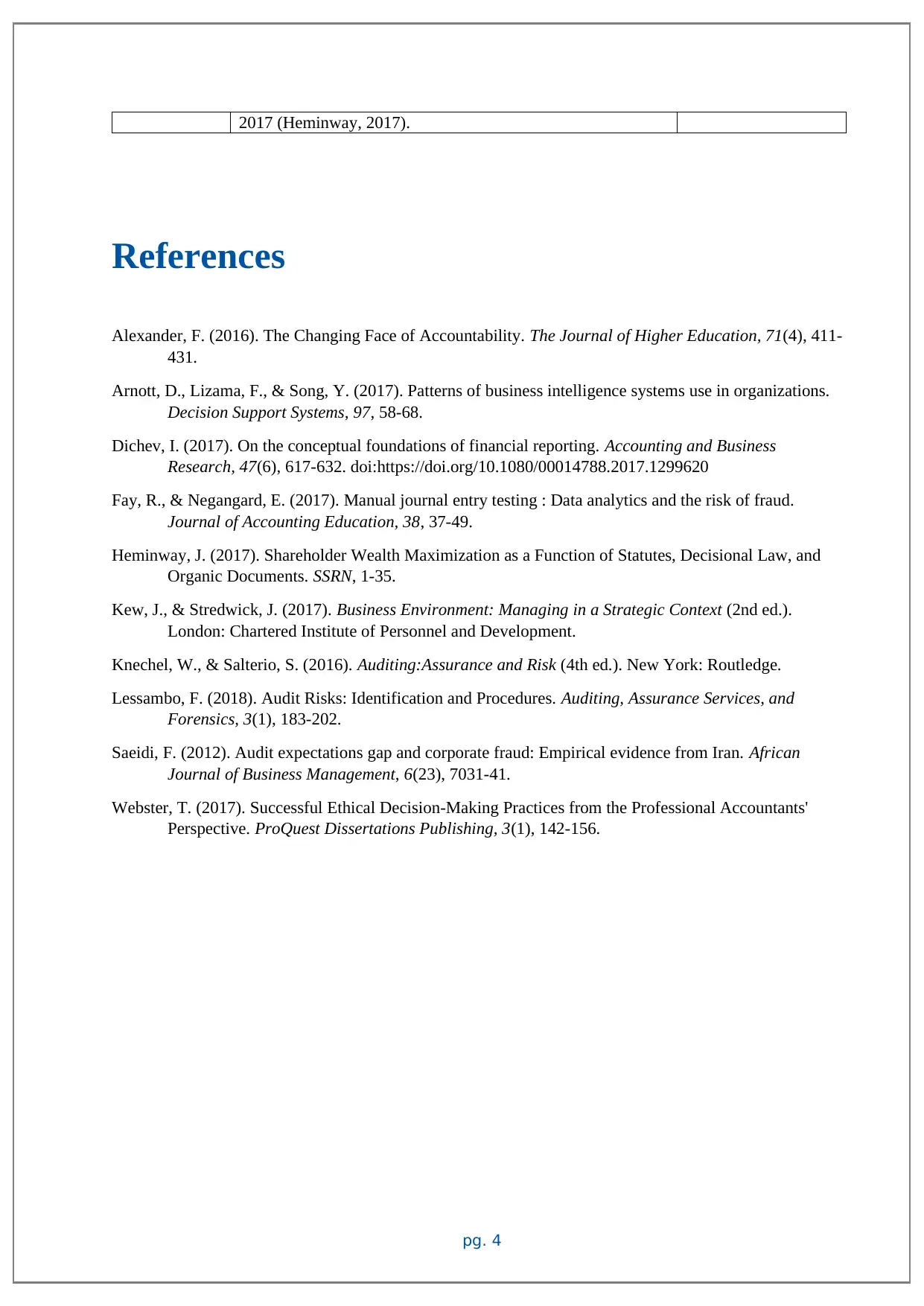
2017 (Heminway, 2017).
References
Alexander, F. (2016). The Changing Face of Accountability. The Journal of Higher Education, 71(4), 411-
431.
Arnott, D., Lizama, F., & Song, Y. (2017). Patterns of business intelligence systems use in organizations.
Decision Support Systems, 97, 58-68.
Dichev, I. (2017). On the conceptual foundations of financial reporting. Accounting and Business
Research, 47(6), 617-632. doi:https://doi.org/10.1080/00014788.2017.1299620
Fay, R., & Negangard, E. (2017). Manual journal entry testing : Data analytics and the risk of fraud.
Journal of Accounting Education, 38, 37-49.
Heminway, J. (2017). Shareholder Wealth Maximization as a Function of Statutes, Decisional Law, and
Organic Documents. SSRN, 1-35.
Kew, J., & Stredwick, J. (2017). Business Environment: Managing in a Strategic Context (2nd ed.).
London: Chartered Institute of Personnel and Development.
Knechel, W., & Salterio, S. (2016). Auditing:Assurance and Risk (4th ed.). New York: Routledge.
Lessambo, F. (2018). Audit Risks: Identification and Procedures. Auditing, Assurance Services, and
Forensics, 3(1), 183-202.
Saeidi, F. (2012). Audit expectations gap and corporate fraud: Empirical evidence from Iran. African
Journal of Business Management, 6(23), 7031-41.
Webster, T. (2017). Successful Ethical Decision-Making Practices from the Professional Accountants'
Perspective. ProQuest Dissertations Publishing, 3(1), 142-156.
pg. 4
References
Alexander, F. (2016). The Changing Face of Accountability. The Journal of Higher Education, 71(4), 411-
431.
Arnott, D., Lizama, F., & Song, Y. (2017). Patterns of business intelligence systems use in organizations.
Decision Support Systems, 97, 58-68.
Dichev, I. (2017). On the conceptual foundations of financial reporting. Accounting and Business
Research, 47(6), 617-632. doi:https://doi.org/10.1080/00014788.2017.1299620
Fay, R., & Negangard, E. (2017). Manual journal entry testing : Data analytics and the risk of fraud.
Journal of Accounting Education, 38, 37-49.
Heminway, J. (2017). Shareholder Wealth Maximization as a Function of Statutes, Decisional Law, and
Organic Documents. SSRN, 1-35.
Kew, J., & Stredwick, J. (2017). Business Environment: Managing in a Strategic Context (2nd ed.).
London: Chartered Institute of Personnel and Development.
Knechel, W., & Salterio, S. (2016). Auditing:Assurance and Risk (4th ed.). New York: Routledge.
Lessambo, F. (2018). Audit Risks: Identification and Procedures. Auditing, Assurance Services, and
Forensics, 3(1), 183-202.
Saeidi, F. (2012). Audit expectations gap and corporate fraud: Empirical evidence from Iran. African
Journal of Business Management, 6(23), 7031-41.
Webster, T. (2017). Successful Ethical Decision-Making Practices from the Professional Accountants'
Perspective. ProQuest Dissertations Publishing, 3(1), 142-156.
pg. 4
1 out of 5
Related Documents
Your All-in-One AI-Powered Toolkit for Academic Success.
+13062052269
info@desklib.com
Available 24*7 on WhatsApp / Email
![[object Object]](/_next/static/media/star-bottom.7253800d.svg)
Unlock your academic potential
Copyright © 2020–2025 A2Z Services. All Rights Reserved. Developed and managed by ZUCOL.




